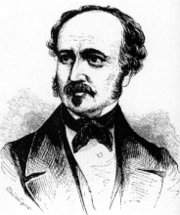John Sutter
|
|
Johann Augustus Sutter (February 15, 1803–June 18, 1880) was a Californian famous for his association with the California Gold Rush (in that gold was discovered by James W. Marshall in Sutter's Mill) and for establishing Sutter's Fort in an area that would later become the capital of California, Sacramento. Although famous throughout California for his association with the Gold Rush, Sutter ironically died quite poor, having seen his business ventures fail while those of his son, Augustus Sutter, prospered.
Life History
Sutter was born as Johann Augustus Suter (the second t was added later) on February 15, 1803 in Kandern, Baden, Germany, while his father came from a nearby town in Switzerland. Debts incurred in business dealings, however, compelled Sutter to leave Europe for the United States. Sutter undertook extensive travels and was eventually helped by friends to come to New York. With 35 other Germans he then moved to Santa Fe, then moving to Honolulu and later Oregon. From the Russian colony at Sitka, Alaska he traveled by sail to San Francisco, at that time a tiny poor mission station.
At the time of Sutter's arrival in California, the territory had only a population of only 5,000 Europeans, in contrast with 30,000 Native Americans. It was at that point a part of Mexico and the governor Juan Bautista Alvarado granted him permission to settle; in order to qualify for a land grant, Sutter became a Mexican citizen on August 29, 1840 - the following year, on June 18, he received title to 48,827 acres (198 km²). Sutter named his settlement "Nuevo Helvetia," or "New Switzerland," after his homeland. Sutter employed variously Indians, Kanakas and Europeans at his compound, which he called Fort Sutter; He envisioned creating an agricultural utopia, and for a time the settlement was in fact quite large and prosperous. It was for a period the destination for most California-bound immigrants, including the ill-fated Donner Party, whom Sutter tried to rescue.
In 1847 the Mexican land was handed over to the United States. Sutter at first supported the establishment of an independent California Republic but when Union troops briefly seized control of his fort, Sutter did not resist because he was outnumbered. In 1848 gold was discovered near his sawmill in Coloma along the American River. Sutter's attempt at keeping this quiet failed when merchant and newspaper publisher Samuel Brannan returned from Sutter's Mill to San Francisco with gold he had acquired there and began publicizing the find. Masses of people overtook the land and destroyed nearly everything Sutter had worked for. In order to keep from losing everything, however, Sutter deeded his remaining land to his son, Augustus Sutter The younger Sutter saw the commercial possibilies of the land and promptly started plans for building a new city he named Sacramento, after the Sacramento River. The elder Sutter deeply resented this because he had wanted the city center to be in nearby Sutterville.
Sutter's El Sobrante land grant was challenged by the Squatter's Association and in 1858 the US supreme court denied it validity. Sutter sought reimbursement of his losses associated with the Gold Rush. He started to receive a pension of $250 a month not as a relief, but as reimbursement of taxes paid on the Sobrante grant at the time Sutter considered it his own. He and wife Nanette moved to Lititz, Pennsylvania. From there he personally petitioned Congress in his case of seeking reimbursement for his losses. In 1880 the Federal government was ready to grant this, but before he could receive any reimbursement, he died on June 18th, 1880.
Had he been able to enjoy his findings, he would have been one of the wealthiest men in the world.
Sutter County, California is named in his honor.de:Johann August Sutter

